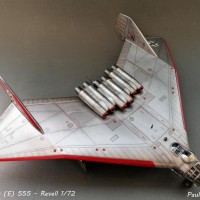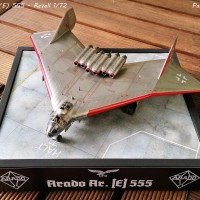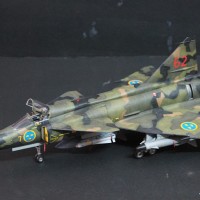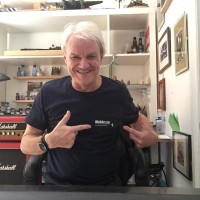Arado Ar. (E) 555 ( Revell 1/72 )
In mid-December 1943, at the Arado facilities in Landeshut/Schlesien, work began on a flying wing project series under the direction of Dr.-Ing. W. Laute. This was further elaborated by Dipl. Ing. Kosin and Lehmann of Arado under the title of "Long Range/High Speed Flying Wing Aircraft". A discussion took place with the RLM several months later in early 1944, and Arado was asked to compile design studies for a long range jet powered bomber. Since the requirements were high speed, a bomb load of at least 4000 kg (8818 lbs) and a range of 5000 km (3107 miles), it was realized that the project could best be fulfilled by using a flying wing design with a laminar high speed profile. The number of designs eventually reached fifteen, and included strategic bombers, remote controlled weapons carriers and fighters.
The Arado Ar E.555-1 was constructed entirely of metal (both steel and Duraluminum), and was basically a flying wing with a short, circular cross section forward fuselage where the pressurized cockpit was located. There were two large vertical fins and rudders that sat 6.2 m (20' 4") from the centerline of the aircraft. The main landing gear undercarriage consisted of two tandem, dual wheeled units that retracted inwards into the wing, and the front landing gear was a single, dual wheeled unit that retracted to the rear to lie beneath the cockpit. A droppable auxialiary landing gear could be used for overload conditions. Power was to be provided by six BMW 003A, all located on the rear upper surface of the wing. Defensive armament consisted of two MK 103 30mm cannon in the wing roots near the cockpit, a remote controlled turret armed with two MG 151/20 20mm cannon located just behind the cockpit and a further two MG 151/20 20mm cannon in a remote controlled tail turret, which was controlled via a periscope in a pressurized weapons station behind the cockpit area.
On December 28, 1944, Arado was ordered to cease all work on the E.555 series, probably due to the worsening war situation, and the need to concentrate aircraft development and production on fighters.
Source: Luft46 – http://www.luft46.com

























marvelous work...real eye candy
Thank you!
Cool. Never seen it in NMF before. Predecessor to Avro Vulcan...?
Who knows?
Nice one Paulo!
Tell us a litle bit about the kit, please. How's the fit, detail and so on.
Your built is awesome, congratulations 😀
Parabéns!
Ok. Thank you!
Nicely done, looks like it might be out of an Indiana Jones story!
Thank you!
You are an expert of the natural metal finish, well done!
Expert, not at all. Thank you!
Excelente!
Obrigado!
Nicely done unique subject Paulo, welcome to iModeler.
Thank you!
Excellent job, Paulo. What an inspiration. The base looks outstanding too.
Welcome aboard!
All the best!
Thank you!
This looks so cool in natural metal.
Thank you!
Wow, nicely done indeed.
Thank you!
Germany was the leader in jet and plane design. Many types that came out by the victors after war ended were their ideas under development .
What a machine ! Beautiful work you did.
Thank you!
Wow - the NMF work is fantastic, and such an unusual subject. Well done!
Thank you!
Wow.
Thank you!
Stunning job‼️
Thank you!
Just found this article, fantastic NMF finish Paulo, really amazing
Thank you!
Paulo,
Great artful choice to use the NMF on this particular aircraft. I would like to know what paints you used for this
excellent NMF effect? If you don't want to share that, no worries. Thank you for sharing your work!
1 attached image. Click to enlarge.
Thanks for your comment.
The paints used were different shades of AK Extreme Metal, surface polish, then a coat of AK Intermediate Gauzy Agent, polish again.
I also used in the weathering phase, some metallic pigments applied with a cotton swab.